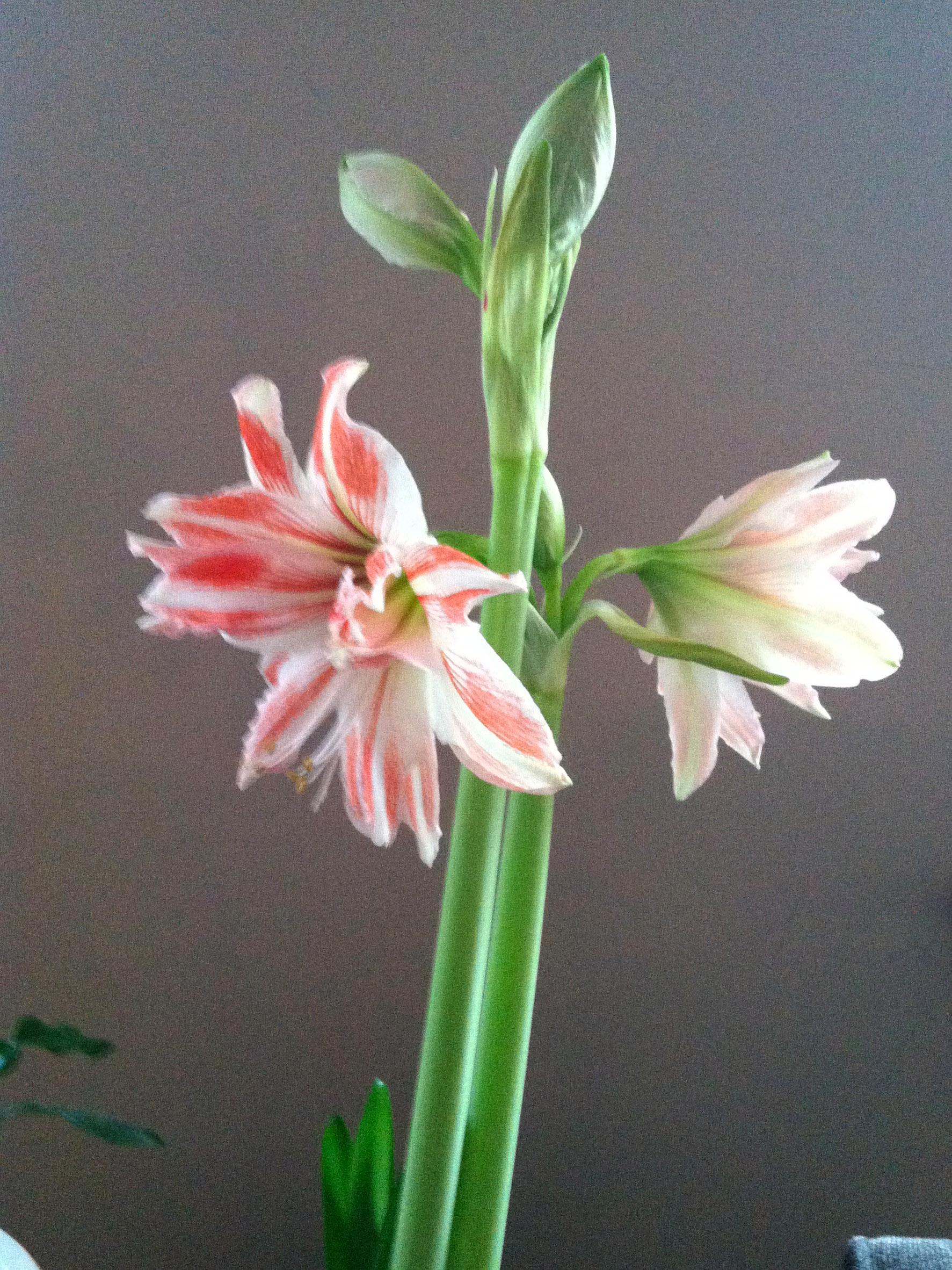
Matthew’s beautiful Amaryllis. Photo courtesy of Matthew Roberts
Have gardening questions or planting needs? Matthew Roberts at Ginkgo Gardens can help you get started or keep your established garden flourishing with his knowledge and expertise.
Hip, hip, and finally hooray – Daylight Savings has arrived! Although it is still literally freezing cold outside at night, the days are getting longer and soon true spring will arrive.
I’m kind of an original thinker when it comes to time. For me, spring seems to start as soon as the Solstice is over and the days start to lengthen –albeit to astronomers and just about everyone else that’s when winter starts. And to them, the Vernal Equinox on March 21/22nd signals true spring. This brings up the issue of what makes a flower bloom – warmth or light? The answer is plus or minus both!
Different plants are triggered to bloom by different stimuli. The tricky Christmas cactus (which isn’t actually a cactus anyway) needs long periods of darkness to initiate blooms.
Meanwhile, that other winter delight –the clivia– flowers after a period of enforced chill. And the spectacular amaryllis (like the glorious orange and white striped mammoth that’s finally blooming on my coffee table) needs both cool temperatures and artificial dark to induce the out-of-season beauties we look forward to in the dank depths of winter.
African violets, on the other hand, do best with almost exactly twelve hours of sunlight and twelve hours of night, hence the often use of artificial lights to keep those fuzzy delights in perpetual bloom.
Outside temperatures have remained stubbornly low even though the earth is still reliably spinning and our axial tilt turns the northern hemisphere back towards the sun, so the increase in daylight is signaling the flora to wake up and start doing its thing. Don’t worry.
Even if you see (and you will if you pay attention) buds forming and bulbs peeking forth, they are safe and sound from the cold. Japanese magnolias have a particularly fine calyx (that part of the flower that wraps around and encloses the corolla, stamen & pistil – the parts that we tend to think of as “the flower”) which is furry and pale grey and filled with hope. These will protect the tender petals but are beautiful in their own right as well. Once the sufficient amount of light has been registered the flowers will be ready, but will wait for a few days of solid warmth to put on their gorgeous and fragrant display. The star magnolias (Magnolia stellata) appear first with a frilly white appearance and light spicy scent. A week or two later the tulip magnolias (Magnolia x soulangiana) blossom in shades of pink, lavender, and deep mauve with a headier odor that can be perceived from yards away.
The famous and traditional cherry blossoms (Prunus “yoshino”) surrounding the Tidal Basin, as well as numerous front and rear gardens on Capitol Hill, typically peak around April 4th, but this year I feel sure that they will be a little bit late. However, don’t book that hotel room for your out-of-town guests based on my opinion. Check the National Park Service website for their expert opinion. Those guys have been spot on year after year.
Be on the lookout for the Bradford and Cleveland pears (Prunus calleryana) which are typically the first of the larger flowering fruit trees. Their clustered bunches of snow white flowers last only a few days to possibly a week and have a peculiar scent of which some are fond and others are not. The trickster of the bunch is the flowering plum (numerous Prunus species and sub-species) whose growth pattern and flower shape are very similar to the cherry. The easy-to-spot differences are that the petals on a plum are a much rosier pink than a cherry blossom, which is just the palest of pinks on the outside and usually almost white on the inside. Also, they bloom almost a full three weeks prior to the cherry. It happens every year that someone is fooled by the precocious plum blossom mistaking them for her sedate later flowering sister, DC’s beloved cherry.
As a final footnote concerning heat vs. light; realize that most seeds don’t need light to germinate – they’re down under the soil anyway. Heat is quite often the trigger, so skip the windowsill, which can be chilly, and start your veggies and flowers on top of the refrigerator where the expelled warmth will give them a little push toward growth. Once they’ve sprouted and put out their first true leaves then move them into the light. Remember that growlights have a diminished effect the farther away they are. Optimal distance is typically six to eight inches and no more than a foot.
One final trick I learned from another master gardener (that has nothing to do with light or heat, but is kinda cool): turn an oscillating fan on near your seedlings. Not only will it help prevent mold and fungus issues that can arise in stagnant air spaces, but it will strengthen the tiny plants’ stems preparing them for the day they are transplanted into the garden.
Happy gardening!
